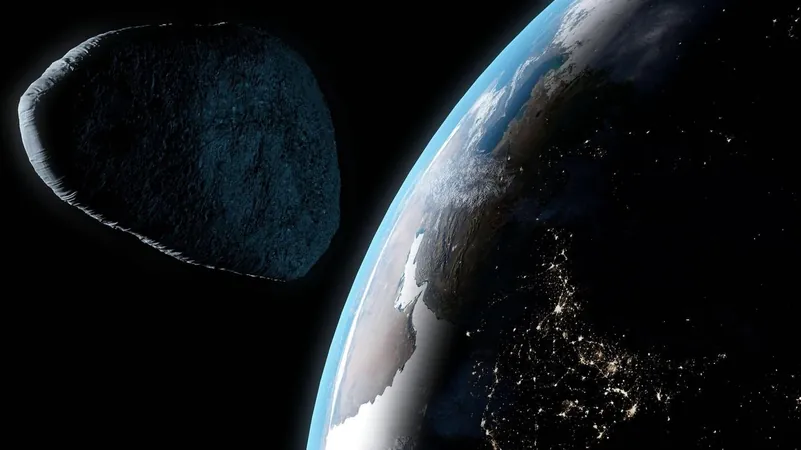
Asteroid Apophis: A Cosmic Close Encounter Reveals New Insights for Planetary Defense
2024-10-05
Asteroid Apophis: A Cosmic Close Encounter Reveals New Insights for Planetary Defense
In April 2029, the asteroid Apophis, weighing in at an astonishing 20 million tons, will make a remarkable close approach to Earth—a moment scientists have been eagerly anticipating. This celestial giant, named after the Egyptian god of chaos, will glide past our planet, coming within approximately 20,000 miles—closer than any similarly-sized asteroid has ever approached in recorded history.
Traveling at a blistering speed of around 19 miles per second, Apophis will be visible from various parts of the world, with locations in Australia, Asia, Europe, and Africa offering the best views. As Hofstra University astronomer Stephen Lawrence notes, “While it won’t shine as brightly as a star, you’ll be able to spot it moving across the sky, a rare sight for anyone alive today.”
Despite initial 2004 calculations suggesting a 2.7% chance of a collision in 2029, which ranked as the highest on the Torino scale used to assess asteroid threat levels, subsequent observations have since ruled out any risk of impact for the next century. The same goes for a previously anticipated collision in 2068, confirmed by advanced radar telescopes. This allows scientists the unique opportunity to study Apophis up close, potentially unlocking clues about the origins of our solar system.
Apophis, with a diameter of about 1,100 feet, is an S-class asteroid, composed mainly of silicate materials, along with nickel and iron—a true relic from the formation of planets 4.6 billion years ago. Bruce Betts, chief scientist for the Planetary Society, emphasizes the significance of studying such asteroids, explaining, “These remnants hold the secrets of the early solar system, containing materials that went unaltered by the forces that reshape our terrestrial world.”
Alongside the close approach of Apophis, NASA's OSIRIS-APEX spacecraft plans a rendezvous in June 2029, where scientists will study how Earth's gravity affects the asteroid's orbit and analyze any geological changes on its surface due to the encounter. This will contribute to our understanding of planetary defense strategies, as we refine methods to track and mitigate potential threats from similar objects in the future.
Planetary defense is more crucial than ever, given that NASA estimates there are millions of near-Earth objects (NEOs) that could pose a risk. Currently, about 50 tons of dust and small objects are swept into Earth’s atmosphere daily. Among the approximately 230,000 NEOs larger than 164 feet, many remain undetected, with less than half of those over 460 feet tracked. Incredibly, there are around 1,000 objects estimated to be over six-tenths of a mile across that could potentially cause global catastrophe.
Vincent Z. Thomas, a planetary scientist, warns of the dangers posed by large asteroids. “A significant collision can unleash the energy equivalent to 100,000 megatons of TNT, reshaping climate and life on Earth—a phenomenon witnessed when the Chicxulub impact devastated the planet and wiped out the dinosaurs,” he asserts.
In preparation for potential asteroid threats, NASA aims to enhance its detection capabilities with the forthcoming NEO Surveyor Mission, expected to launch by 2028. This space-based mission will significantly improve our ability to spot large asteroids and reduce the likelihood of catastrophic impacts.
If a dangerous asteroid is identified, researchers have several defense strategies at their disposal. Options include launching kinetic impactors to alter the asteroid's trajectory, employing gravitational forces from spacecraft to shift its path gradually, or even deploying nuclear devices to deflect or dismantle an approaching threat.
As Bruce Betts aptly puts it, “While we can’t prevent natural disasters like hurricanes or earthquakes, we stand a chance against asteroid threats.” Continuous advancements in planetary defense will be necessary, and the upcoming encounter with Apophis offers a tantalizing glimpse into both the challenges and opportunities that await us in safeguarding our planet from cosmic hazards.




 Brasil (PT)
Brasil (PT)
 Canada (EN)
Canada (EN)
 Chile (ES)
Chile (ES)
 España (ES)
España (ES)
 France (FR)
France (FR)
 Hong Kong (EN)
Hong Kong (EN)
 Italia (IT)
Italia (IT)
 日本 (JA)
日本 (JA)
 Magyarország (HU)
Magyarország (HU)
 Norge (NO)
Norge (NO)
 Polska (PL)
Polska (PL)
 Schweiz (DE)
Schweiz (DE)
 Singapore (EN)
Singapore (EN)
 Sverige (SV)
Sverige (SV)
 Suomi (FI)
Suomi (FI)
 Türkiye (TR)
Türkiye (TR)